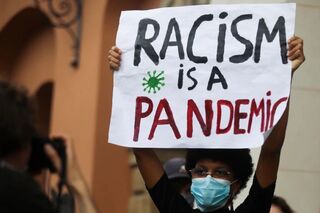Coronavirus Disease 2019
A Social Virus? COVID-19 and Intergroup Relations
The pandemic increases discrimination, but only towards specific groups.
Posted January 24, 2022 Reviewed by Tyler Woods
Key points
- In times of external threat, such as a global pandemic, people tend to find a social group to blame: a scapegoat.
- A study conducted in Israel during the peak of the outbreak identified the type of social groups most susceptible to become scapegoats.

By Shira Hebel-Sela and Eli Adler
In late 2019, a new mysterious virus was spreading in China. A few months later, the entire world was buried under the waves of this virus. Almost no country was left unaffected by COVID-19, and the news about the spread of the pandemic has reached billions worldwide.
Yet, in tandem with the waves of the virus, other kinds of dangerous waves began to spread fast around the world. These were waves of intergroup hatred, racism, and xenophobia targeted at minority groups in numerous countries. These minorities were blamed for spreading the diseases, as society perceives them to be "dirty" or "sickly" (Taylor, 2019). Such accusations were directed at the Asian minority in the United States, where the pandemic led to an increase in hate crimes against Asians. Some Americans even stopped ordering Chinese food and buying at Chinese businesses.
This pattern, however, was not unique to the US. As reported by Human Rights Watch, COVID-related racism and xenophobia have been on the rise in other countries around the globe, not targeting only the Asian population. Existing research shows that the rise of xenophobia towards other racial and ethnic groups is a common phenomenon during pandemics (Hoppe, 2018). The 1918 influenza pandemic, for example, was coined "The Spanish Flu," with all the negative connotations related to it. Indeed, in different countries, various minority groups have been suffering from increased hatred and racism towards them since the COVID-19 outbreak.
Whether hatred and racism during pandemics would be directed to any outgroup or towards outgroups with specific characteristics remains a question. Our research team from the Psychology of Intergroup Conflict and Reconciliation Lab at the Hebrew University of Jerusalem set out to explore the connection between pandemics and outgroup discrimination. More specifically, we sought to identify which groups will be most susceptible to be targets of such discriminatory behaviors. We hypothesized that, like the virus itself, specific groups would be at higher risk of being affected by the social virus of intergroup discrimination.
In our recently published paper in the International Journal of Intercultural Relations, we report findings from a study conducted in Israel during the first wave of COVID-19. We surveyed the Israeli population and examined how exposure and harm from COVID-19 affect attitudes towards different groups in Israel. On a broader level, we aimed to pinpoint the characteristics of these groups, so we could identify vulnerable groups and protect them from being scapegoated.
In times of external threat, especially when the threat is amorphic, people tend to find someone, a person, or a group to blame: a scapegoat. The term "scapegoat" comes from a biblical ceremony in which a goat was released to die in the desert. The goat was symbolically carrying all of the Israelites' sins and transgressions, and by releasing it to the wilderness, their sins were atoned. Fault, blame, and sin were thus embodied in this helpless creature sent to die to relieve humans from guilt and responsibility.
Regrettably, scapegoating is common in everyday life, where people accuse others in order to feel less guilty or evade the consequences of their actions. Another goal of scapegoating is reducing uncertainty during times of threat. Finding someone to blame retrieves peoples' sense of control, certainty, and coherence (Rothschild et al., 2012). Therefore, it is not surprising that the tendency to scapegoat will increase when amorphic threats, such as pandemics, are on the rise.
We specified two types of social groups that can potentially become scapegoats. The first is the Ultimate Scapegoat, a group with whom the in-group has a history of hostilities and longstanding dislike (for Jewish-Israelis, the ultimate scapegoats are the Palestinians). The second is the Context-Related Scapegoat, a group that usually has good relationships with the in-group but can be perceived as threatening in the context of the pandemic (in this case, minority groups in Israel that were perceived as noncompliant with COVID-19 health regulations).
Our study was conducted during the first lockdown in Israel (April 2020), when infection rates were soaring, information about the virus was scant, and anxiety levels were high. Results showed that the outgroups that were scapegoated were related to the contextual threat, as exposure to COVID-19 predicted negative attitudes towards minorities in Israel but not towards the Palestinians. More specifically, greater exposure to COVID-19 led to more dehumanization of these minorities, which made participants less willing to support policies aimed at helping these minorities cope with COVID-19. This is not trivial because, for Israelis, Palestinians are the "default" enemy and therefore the findings are surprising.
These results can shed light on social processes taking place during pandemics and other crises. It is alarming that once normative citizens are exposed to an external crisis, they see others as less human and oppose aiding them. These immediate effects hint at the risks external threats may have on the political and national levels. The fact that participants opposed granting help to their fellow citizens, regardless of its self-harming potential, depicts some of the blindness of scapegoating.
Another insight that emerged from our findings is that an external threat may lead to the harm of a group that is usually part of the ingroup. In contrast, the greatest enemy of the ingroup (in this case, Palestinians) is not affected by that threat. This may raise the question of whether an external threat may actually lead to improved relations between longtime enemies.
Our study points to the disastrous implications that prejudice and negative intergroup attitudes can easily lead to. Awareness of the dangerous implications of scapegoating is crucial to prevent social disasters. Great efforts were directed to characterize and identify populations at higher risk of COVID-19 infection to protect their health. The same efforts should be devoted to the social aspect of the pandemic, so we can save lives and keep social cohesion. Awareness of the human tendency to find someone to blame is the first step in halting the spread of the scapegoating virus.
About the authors:
Shira Hebel is a doctoral student in social psychology at the Hebrew University, co-supervised by Dr. Boaz Hameiri and Prof. Eran Halpern.
Eli Adler is a joint doctoral student in social psychology and neuroscience at the Hebrew University of Jerusalem and at Aalto University, co-supervised by Prof. Eran Halperin, Prof. Iiro Jääskeläinen, and Dr. Yoni Levy.
References
Hoppe, T. (2018). "Spanish Flu": When Infectious Disease Names Blur Origins and Stigmatize Those Infected. American Journal of Public Health, 108(11), 1462–1464. https://doi.org/10.2105/AJPH.2018.304645
Rothschild, Z. K., Landau, M. J., Sullivan, D., & Keefer, L. A. (2012). A dual-motive model of scapegoating: Displacing blame to reduce guilt or increase control. Journal of Personality and Social Psychology, 102(6), 1148–1163. https://doi.org/10.1037/a0027413
Taylor, S. (2019). The psychology of pandemics: Preparing for the next global outbreak of infectious disease. Cambridge Scholars Publishing.




